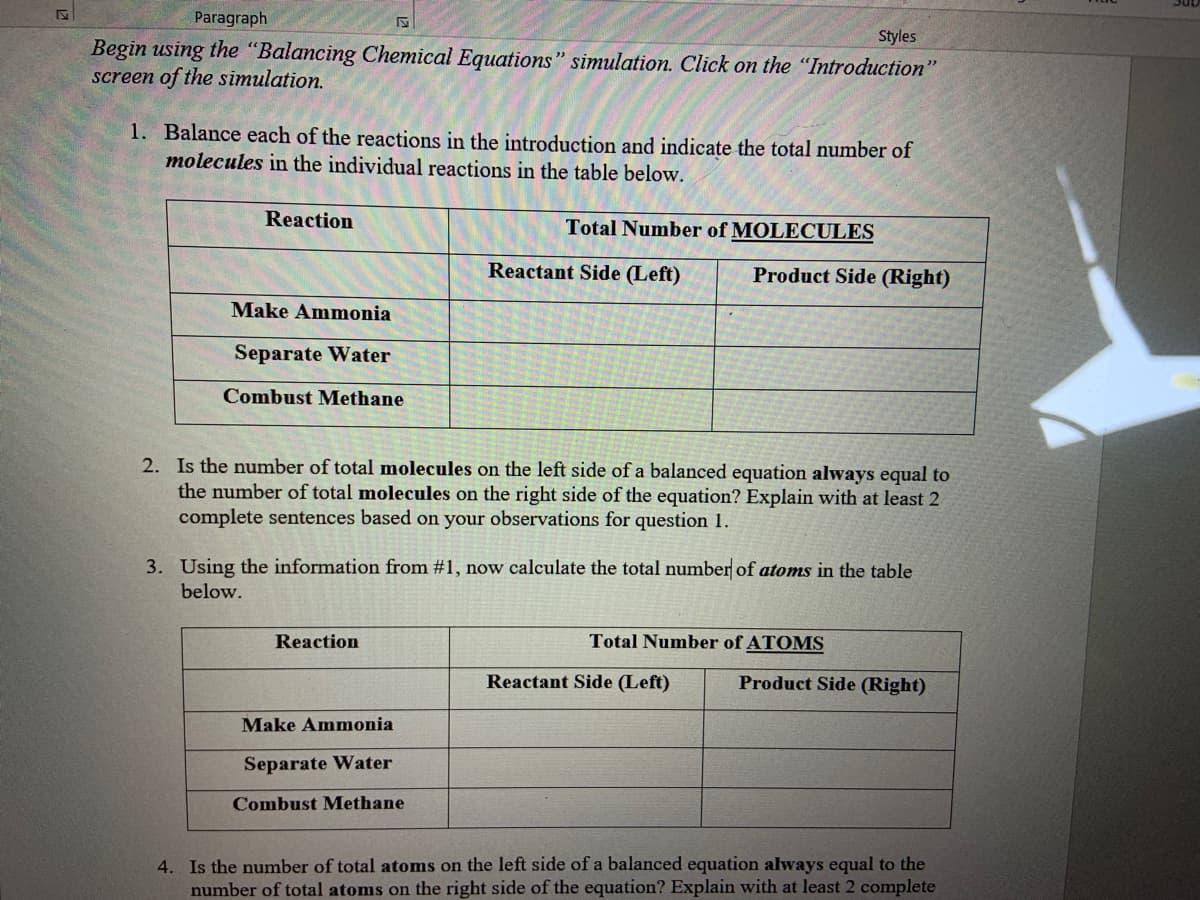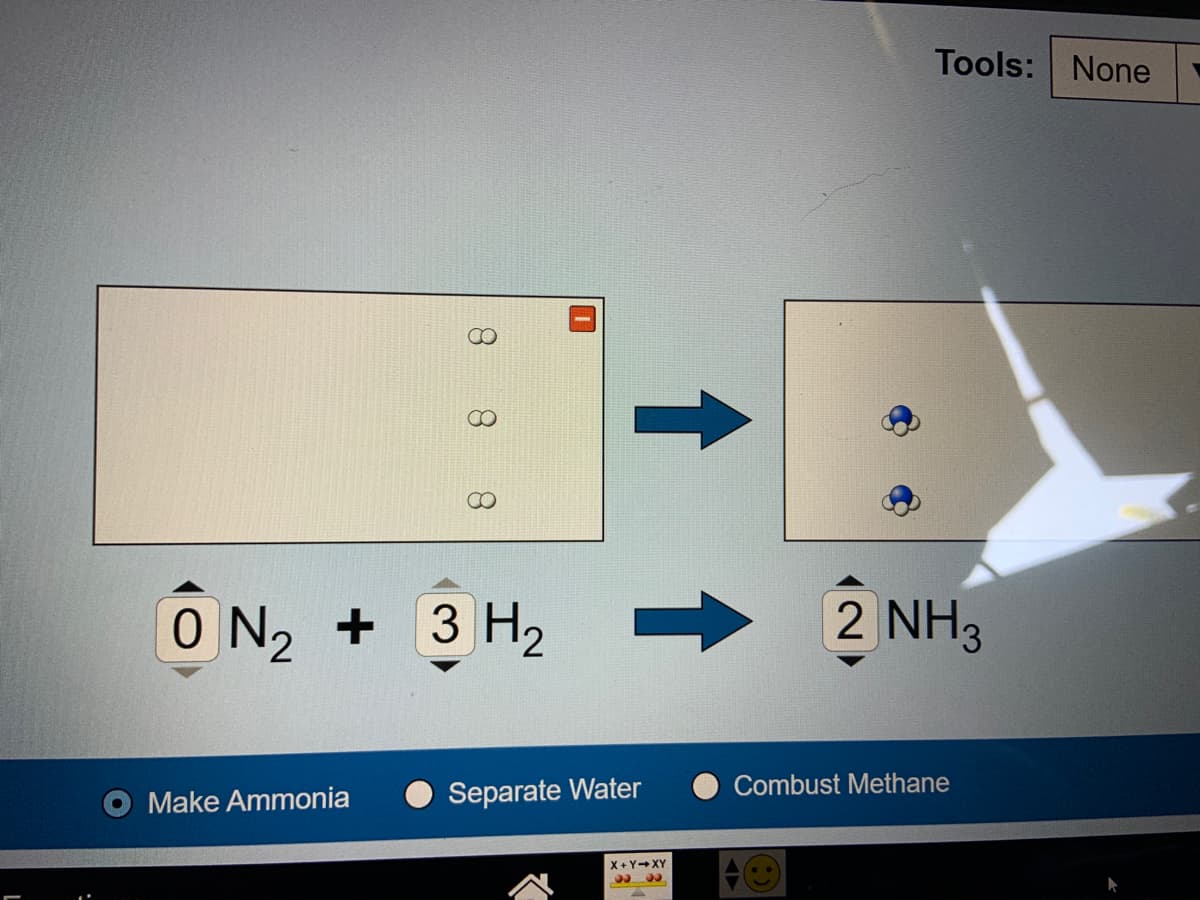1. Balance each of the reactions in the introduction and indicate the total number of molecules in the individual reactions in the table below. Reaction Total Number of MOLECULES Reactant Side (Left) Product Side (Right) Make Ammonia Separate Water Combust Methane 2. Is the number of total molecules on the left side of a balanced equation always equal to the number of total molecules on the right side of the equation? Explain with at least 2 complete sentences based on your observations for question 1. 3. Using the information from #1, now calculate the total number of atoms in the table below. Reaction Total Number of ATOMS Reactant Side (Left) Product Side (Right) Make Ammonia Separate Water Combust Methane 4. Is the number of total atoms on the left side of a balanced equation always equal to the
1. Balance each of the reactions in the introduction and indicate the total number of molecules in the individual reactions in the table below. Reaction Total Number of MOLECULES Reactant Side (Left) Product Side (Right) Make Ammonia Separate Water Combust Methane 2. Is the number of total molecules on the left side of a balanced equation always equal to the number of total molecules on the right side of the equation? Explain with at least 2 complete sentences based on your observations for question 1. 3. Using the information from #1, now calculate the total number of atoms in the table below. Reaction Total Number of ATOMS Reactant Side (Left) Product Side (Right) Make Ammonia Separate Water Combust Methane 4. Is the number of total atoms on the left side of a balanced equation always equal to the
World of Chemistry, 3rd edition
3rd Edition
ISBN:9781133109655
Author:Steven S. Zumdahl, Susan L. Zumdahl, Donald J. DeCoste
Publisher:Steven S. Zumdahl, Susan L. Zumdahl, Donald J. DeCoste
Chapter9: Chemical Quantities
Section: Chapter Questions
Problem 1STP
Related questions
Question
100%
Need help finding total number of molecules on each side and then the total number of atoms. Both for ammonia. Not understanding it...

Transcribed Image Text:Paragraph
Styles
Begin using the "Balancing Chemical Equations" simulation. Click on the "Introduction"
screen of the simulation.
1. Balance each of the reactions in the introduction and indicate the total number of
molecules in the individual reactions in the table below.
Reaction
Total Number of MOLECULES
Reactant Side (Left)
Product Side (Right)
Make Ammonia
Separate Water
Combust Methane
2. Is the number of total molecules on the left side of a balanced equation always equal to
the number of total molecules on the right side of the equation? Explain with at least 2
complete sentences based on your observations for question 1.
3. Using the information from #1, now calculate the total number of atoms in the table
below.
Reaction
Total Number of ATOMS
Reactant Side (Left)
Product Side (Right)
Make Ammonia
Separate Water
Combust Methane
4. Is the number of total atoms on the left side of a balanced equation always equal to the
number of total atoms on the right side of the equation? Explain with at least 2 complete

Transcribed Image Text:Tools: None
ON2
+ 3 H2
2 NH3
Combust Methane
Make Ammonia
Separate Water
X+Y+XY
8.
Expert Solution
This question has been solved!
Explore an expertly crafted, step-by-step solution for a thorough understanding of key concepts.
This is a popular solution!
Trending now
This is a popular solution!
Step by step
Solved in 2 steps with 1 images

Knowledge Booster
Learn more about
Need a deep-dive on the concept behind this application? Look no further. Learn more about this topic, chemistry and related others by exploring similar questions and additional content below.Recommended textbooks for you

World of Chemistry, 3rd edition
Chemistry
ISBN:
9781133109655
Author:
Steven S. Zumdahl, Susan L. Zumdahl, Donald J. DeCoste
Publisher:
Brooks / Cole / Cengage Learning

Introductory Chemistry: An Active Learning Approa…
Chemistry
ISBN:
9781305079250
Author:
Mark S. Cracolice, Ed Peters
Publisher:
Cengage Learning

Introductory Chemistry: A Foundation
Chemistry
ISBN:
9781337399425
Author:
Steven S. Zumdahl, Donald J. DeCoste
Publisher:
Cengage Learning

World of Chemistry, 3rd edition
Chemistry
ISBN:
9781133109655
Author:
Steven S. Zumdahl, Susan L. Zumdahl, Donald J. DeCoste
Publisher:
Brooks / Cole / Cengage Learning

Introductory Chemistry: An Active Learning Approa…
Chemistry
ISBN:
9781305079250
Author:
Mark S. Cracolice, Ed Peters
Publisher:
Cengage Learning

Introductory Chemistry: A Foundation
Chemistry
ISBN:
9781337399425
Author:
Steven S. Zumdahl, Donald J. DeCoste
Publisher:
Cengage Learning

Chemistry: Matter and Change
Chemistry
ISBN:
9780078746376
Author:
Dinah Zike, Laurel Dingrando, Nicholas Hainen, Cheryl Wistrom
Publisher:
Glencoe/McGraw-Hill School Pub Co

Living By Chemistry: First Edition Textbook
Chemistry
ISBN:
9781559539418
Author:
Angelica Stacy
Publisher:
MAC HIGHER

Chemistry: An Atoms First Approach
Chemistry
ISBN:
9781305079243
Author:
Steven S. Zumdahl, Susan A. Zumdahl
Publisher:
Cengage Learning